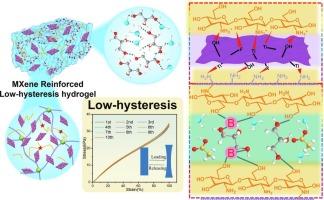Low mechanical-hysteresis conductive hydrogel conferred by chitosan bridging and MXene nanoconfined mechanism
IF 10.7
1区 化学
Q1 CHEMISTRY, APPLIED
引用次数: 0
Abstract
Large mechanical hysteresis, stemming from the inherent viscoelasticity of the hydrogel networks, seriously affected its service life and application scope. Herein, we introduced a synergistic approach combining MXene nanoconfinement and bridging effect to produce hydrogels with low mechanical hysteresis. The introduced MXene was able to provide an effective nanoconfined effect on the polymerization of acrylamide monomers. By synergizing with the bridging effect—facilitated by strong interactions between chitosan-grafted polyacrylamide and solvent molecules to accelerate stress transfer—we successfully developed a MXene-reinforced conductive hydrogel with mechanical hysteresis as low as 3.17 %. Additionally, the strong electrostatic interactions between the chitosan and MXene further affiliate the dispersion of MXene within the hydrogel. The resulting MXene-reinforced conductive hydrogel demonstrated remarkable temperature sensitivity (TCR = −1.42 %/°C), making it suitable to be used as a health monitoring device. These findings opened up new perspectives for the further expansion of MXene and beyond.

壳聚糖桥接和 MXene 纳米约束机制带来的低机械滞后导电水凝胶
水凝胶网络固有的粘弹性导致了较大的机械滞后,严重影响了其使用寿命和应用范围。在此,我们引入了一种将 MXene 纳米致密化和架桥效应相结合的协同方法,以生产低机械滞后的水凝胶。引入的 MXene 能够为丙烯酰胺单体的聚合提供有效的纳米约束效应。壳聚糖接枝聚丙烯酰胺与溶剂分子之间的强相互作用促进了桥接效应,从而加速了应力传递,通过与桥接效应的协同作用,我们成功开发出了一种 MXene 增强导电水凝胶,其机械滞后低至 3.17%。此外,壳聚糖和 MXene 之间强大的静电相互作用进一步促进了 MXene 在水凝胶中的分散。由此产生的 MXene 增强导电水凝胶具有显著的温度灵敏度(TCR = -1.42 %/°C),适合用作健康监测设备。这些发现为进一步扩展 MXene 及其他材料开辟了新的前景。
本文章由计算机程序翻译,如有差异,请以英文原文为准。
求助全文
约1分钟内获得全文
求助全文
来源期刊

Carbohydrate Polymers
化学-高分子科学
CiteScore
22.40
自引率
8.00%
发文量
1286
审稿时长
47 days
期刊介绍:
Carbohydrate Polymers stands as a prominent journal in the glycoscience field, dedicated to exploring and harnessing the potential of polysaccharides with applications spanning bioenergy, bioplastics, biomaterials, biorefining, chemistry, drug delivery, food, health, nanotechnology, packaging, paper, pharmaceuticals, medicine, oil recovery, textiles, tissue engineering, wood, and various aspects of glycoscience.
The journal emphasizes the central role of well-characterized carbohydrate polymers, highlighting their significance as the primary focus rather than a peripheral topic. Each paper must prominently feature at least one named carbohydrate polymer, evident in both citation and title, with a commitment to innovative research that advances scientific knowledge.
 求助内容:
求助内容: 应助结果提醒方式:
应助结果提醒方式:


